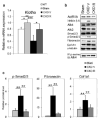The chronic kidney disease - Mineral bone disorder (CKD-MBD): Advances in pathophysiology
- PMID: 28119179
- PMCID: PMC5502716
- DOI: 10.1016/j.bone.2017.01.023
The chronic kidney disease - Mineral bone disorder (CKD-MBD): Advances in pathophysiology
Abstract
The causes of excess cardiovascular mortality associated with chronic kidney disease (CKD) have been attributed in part to the CKD-mineral bone disorder syndrome (CKD-MBD), wherein, novel cardiovascular risk factors have been identified. New advances in the causes of the CKD-MBD are discussed in this review. They demonstrate that repair and disease processes in the kidneys release factors to the circulation that cause the systemic complications of CKD. The discovery of WNT inhibitors, especially Dickkopf 1 (Dkk1), produced during renal repair as participating in the pathogenesis of the vascular and skeletal components of the CKD-MBD implied that additional pathogenic factors are critical. This lead to the discovery that activin A is a second renal repair factor circulating in increased levels during CKD. Activin A derives from peritubular myofibroblasts of diseased kidneys, wherein it stimulates fibrosis, and decreases tubular klotho expression. Activin A binds to the type 2 activin A receptor, ActRIIA, which is variably affected by CKD in the vasculature. In diabetic/atherosclerotic aortas, specifically in vascular smooth muscle cells (VSMC), ActRIIA signaling is inhibited and contributes to CKD induced VSMC dedifferentiation, osteogenic transition and neointimal atherosclerotic calcification. In nondiabetic/nonatherosclerotic aortas, CKD increases VSMC ActRIIA signaling, and vascular fibroblast signaling causing the latter to undergo osteogenic transition and stimulate vascular calcification. In both vascular situations, a ligand trap for ActRIIA prevented vascular calcification. In the skeleton, activin A is responsible for CKD stimulation of osteoclastogenesis and bone remodeling increasing bone turnover. These studies demonstrate that circulating renal repair and injury factors are causal of the CKD-MBD and CKD associated cardiovascular disease.
Keywords: Activin; CKD-MBD; Dickkhopf 1; FGF23; Klotho; Parathyroid hormone; Renal osteodystrophy; Vascular calcification.
Copyright © 2017 Elsevier Inc. All rights reserved.
Figures



References
-
- Jha V, Garcia-Garcia G, Iseki K, et al. Chronic kidney disease: global dimension and perspectives. The Lancet. 2013;382(9888):260–272. - PubMed
-
- Sarnak MJ, Levey AS, Schoolwerth AC, et al. Kidney Disease as a Risk Factor for Development of Cardiovascular Disease. Circulation. 2003;108(17):2154–2169. - PubMed
-
- Go AS, Chertow GM, Fan D, McCulloch CE, Hsu Cy. Chronic kidney disease and the risks of death, cardiovascular events, and hospitalization. New Engl J Med. 2004;351:1296–1305. - PubMed
-
- Tonelli M, Wiebe N, Culleton B, et al. Chronic kidney disease and mortality risk: A systematic review. J Am Soc Nephrol. 2006;17:2034–2047. - PubMed
-
- Vanholder R, Massy Z, Argiles A, et al. Chronic kidney disease as cause of cardiovascular morbidity and mortality. Nephrology Dialysis Transplantation. 2005;20:1048–1056. - PubMed
Publication types
MeSH terms
Substances
Grants and funding
LinkOut - more resources
Full Text Sources
Other Literature Sources
Medical

